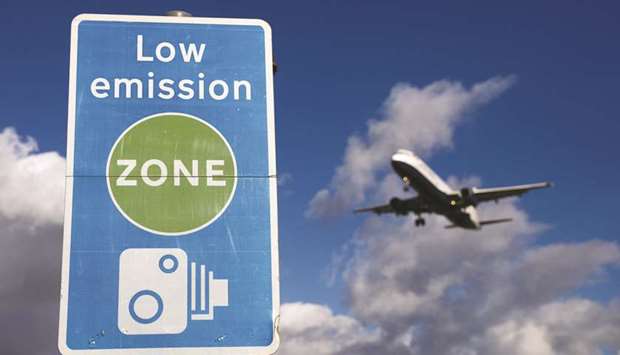Reducing climate change is indeed a serious global challenge.
The transport sector contributed 27% of greenhouse gas (GHG) emissions in the EU in 2016, European Environment Agency data show, while aviation accounted for 13% of all transport emissions, according to the European Union Aviation Safety Agency (EASA).
Overall, aviation emissions are responsible for about 3.6% of GHG emissions in the EU and about 2% globally.
Pressure to de-carbonise will continue to grow on the global airline sector, a large contributor to carbon dioxide (CO2) emissions,
Fitch Ratings said and noted reductions in net aviation CO2 emissions at the global and local levels are not achievable without a combination of prudent management of air traffic growth and financially demanding regulation to incentivise airlines to reduce emissions.
The researcher also believes it requires a consistent and coordinated global approach. Government policies that could curb air travel and incentivise alternative choices could disrupt the aviation sector and may have credit implications, but this is unlikely in the short to medium term.
Several international organisations and national governments have set targets for emission reduction.
For example, the International Air Transport Association (IATA) aims to reduce net aviation CO2 emissions by 50% by 2050 relative to 2005’s level.
The UK government has committed to reach net zero greenhouse gas emissions by 2050 (including international aviation).
Fitch Ratings view these targets as “ambitious and requiring constraints” on traffic growth, in addition to “improvements” in aircraft fuel efficiency and “gradual introduction” of sustainable biofuels.
New aircraft are said to be 15% to 20% more fuel efficient. But gradual fleet replacement leads to improvement in aircraft fuel efficiency of only 1.5% a year on average, Fitch Ratings noted in a recent research report.
This, it said is not enough to offset annual global passenger traffic growth of more than 5% during the past five years. Global CO2 emissions from air travel have therefore grown at a CAGR of 3.9% over the past 10 years.
However, improved aircraft efficiency and densification helped to cut per passenger CO2 emissions by 2.3% CAGR over the same period.
The base case for the airline sector drawn by the researcher assumes “healthy passenger growth” in the next three to five years. However, social and policy developments may provide a strong incentive for de-carbonisation and cause disruption in the sector.
These developments include growing emission awareness, environmentally focused customer choices and pressure groups discouraging others from flying (e.g. the ‘flygskam’, or ‘flight shame’ movement in Scandinavia).
There are also proposed government policies that could curb air travel, for example, additional aviation taxation and incentives for rail choices, especially for short-haul trips.
The UK Committee on Climate Change estimated that aviation emissions can be reduced by about 20% by 2050 from today’s level by limiting demand growth to 25% above the current level, along with fuel efficiency improvements and some use of sustainable fuels.
The former could be achieved through additional taxation and frequent flyer levies, among other things.
Fitch Ratings do not expect the airline sector to be exposed to the same degree of transformation as European utilities (which have been undergoing the energy transition with focus on renewables and effective ban on new coal-fired power and decommissioning of existing coal plants in some countries), at least in the short to medium term.
This is due to air travel having limited alternatives, especially on longer distances and/or inter-continental connections. There are also limited commercially viable sustainable fuels and technologies available in aviation at present.
New technologies to replace conventional engines with hybrid or electric ones will take a long time to develop and put into commercial production. Sustainable aviation fuels (such as carbon-neutral synthetic electro-fuels and biofuels) are much more expensive than fossil-based jet fuels (e.g. electro-fuels are three to six times more expensive).
Fuel costs are estimated to make up about 30% of airlines’ operating costs.
In addition, biofuels for aviation in the EU are produced in only a few facilities; their total capacity could cover only about 4% of the aviation sector fuel needs.
The global body of airlines — IATA said it recognises the need to address the global challenge of climate change and adopted a set of ambitious targets to mitigate CO2 emissions from air transport.
These include an average improvement in fuel efficiency of 1.5% per year from 2009 to 2020, a cap on net aviation CO2 emissions from 2020 (carbon-neutral growth) and a reduction in net aviation CO2 emissions of 50% by 2050, relative to 2005 levels.
IATA director general and CEO Alexandre de Juniac said, “It is our duty to protect the planet from the disastrous impacts of climate change. Some say that the answer to climate change is to stop or heavily reduce flying. That would have grave consequences for people, jobs, and economies the world over. It would be a step backward to an isolated society that is smaller, poorer and constrained. I say, let’s work together to make flying sustainable. CO2 is the problem. We can and are doing something meaningful to reduce it.”
* Pratap John is Business Editorat Gulf Times.

An aircraft passes a low emission zone sign as it prepares to land at Heathrow airport in London. Aviation accounted for 13% of all transport emissions, according to the European Union Aviation Safety Agency.


